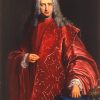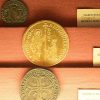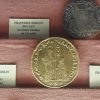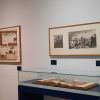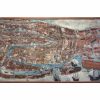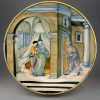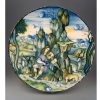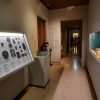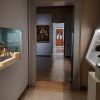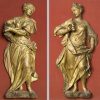Along with the Neoclassical section, the first floor of the museum is occupied by 20 rooms which illustrate the life and culture of the Venetian Republic over the centuries of its political grandeur and independence. Rather than offering a continuous narrative, the presentation covers various themes and issues which conjure up an idea of Venice at the time, providing an insight into the events of the city’s history and aspects of its institutions and political system.
NOTICE TO THE PUBLIC: * from June 28, 2019 some rooms of the “Civiltà Veneziana” are used for the exhibition “Francesco Morosini: the last Serenissima’s hero between history and myth” >
8. Pisani Library in San Vidal. This room is lined with monumental bookcases in walnut that come from the Pisani Family palace at San Vidal, which now houses the Venice Conservatoire. These magnificent examples of 17th century furnishings are decorated using architectural motifs. The two orders with their elegant fluted Corinthian columns clearly reflect the classically-inspired taste of the day, whilst a touch of the Baroque tastes to come can be seen in the large volutes of the upper order of columns. The bookcases themselves hold rare manuscripts, and printed works dating from the early 16th century to the end of the 18th, together with the museum’s large collection of ducal orders and regulations. In fact, the Pisani were the first to set up what might be called a library-museum, in an attempt to endow the city’s publishing industry with its own aura of grandeur and munificent service to the State. In the centre of the room is an imposing 18th century chandelier of Murano glass. Like the one in the next room, this was probably produced at the famous workshop of Giuseppe Briati.
9/10 The Magistrature (Civil Authorities). These rooms house the portraits of Venetian noblemen wearing the traditional gowns of the Republic’s various magistratures. They include a number of Senators and Procuratori di San Marco – with their edged and embroidered velvet stoles – who, in the State hierarchy, occupied a position immediately below the Doge. The noble austerity and sober elegance of these official gowns underlined the dignity and decorum befitting such figures, and was a visual reminder that public office was essentially concerned with rendering service to the State. Note the portrait of the Bailo Giovanni Emo which is attributed to Pietro Uberti (1671–1762). The Bailo, Venetian ambassador to Constantinople, was elected by the Senate and held a very powerful post, given that as well as maintaining links with the Ottoman authorities, he was also governor of the Venetian community within Constantinople. This portrait is followed by that of Vincenzo Querini by Bartolomeo Nazzari (1699-1750).
11. Coinage. The Museo Correr has an extraordinary collection that includes an almost complete set of the coins minted by the Republic of Venice from its very foundation (ca. 820) to its end (1797). The showcases contain a rich selection of these pieces laid out chronologically, clockwise round the room (the oldest pieces are in the display cases along the wall to the left). The coins themselves mark out the development of the city’s history, in which trade and Venice’s strategic position as an international cross-roads also played key roles. And such characteristics were inevitably reflected in the currency coined by the Republic. From the 9th to the 20th century, the Venetian Mint issued imperial coins; the last of these date from the reign of Henry IV or V of Franconia (1065–1125). The first coins to be minted in the name of a Doge date from the reign of Doge Vitale II Michiel (1156–1172), whilst the period of Enrico Dandolo (1192–1205) saw the introduction of a new, almost totally pure, silver coin that was much heavier than other comparable pieces of the day: the ducato or grosso matapan. It is not clear whether this was the first large denomination coin in Europe, but it is certain that Venice would make it a great international success, the most welcome “currency” in the entire Mediterranean basin. In 1285, when Giovanni Dandolo was Doge, Venice then minted its own gold coin, the ducato d’oro; in weight and purity, this was the exact equivalent of the famous gold florins of Florence. Soon rivalling that florin, the ducat – which in the time of Doge Francesco Donà (1545-1553) took on the name of zecchino (sequin) – became the currency of Venice’s international trade and would be imitated in many regions of the world, from Europe to India. Degree of purity and standard weight would be the main characteristics of the zecchino, a coin whose very appearance remained unchanged for 250 years. At the end of the fifteenth century new silver deposits were discovered in Central Europe and then, later, would come the influx of gold and silver from the Americas. This led to a change in coinage throughout Europe, but Venice was the first city to issue the new types of coins – in 1472, when Niccolò Tron was Doge; this large silver coin to the value of one lira became known as the lira tron or the trono. From that moment on, the lira, which previously had been solely an accounting unit, became a veritable coin. Throughout the sixteenth century Venice would remain one of the most important market-places in the West for precious metals; however, it was gradually losing its central place in international trade. From this point on the Venetian Mint began to produce new and large denominations such as the silver ducato and scudo, as well as issuing coins that had not previously been minted in the city – for example, the French-derived gold scudo (Doge Andrea Gritti 1523-1539); the Leone for eastern trade (Doge Francesco Morosini, 1688-1694), which was based on the very widely-used Dutch leewvedaalder (lion thalers); or the eastern tallero, coined from 1756 onwards in imitation of the Maria Theresa thaler that was then the dominant currency in Eastern trade. Ending with the coins minted under the last Doge, Ludovico Manin, in 1797, this chronological review is followed by two display-cases dedicated to oselle, a sort of coin/medal which was cast mainly in silver. The origin of the name is rather curious: since the second half of the twelfth century there had been a tradition for the Doge to present the patricians of the city with a New Year’s gift of five marshland gamebirds (osei). Eventually this gift was replaced by an equivalent in money and, from 1521 onwards, a special coin was minted for the occasion, the osella. The tradition thereafter remained in practice right up to 1797. The last display-case is dedicated to minted tokens (tessere) of various kinds, produced from the fourteenth century onwards: there are rationing tessere, which poor families could then use in purchasing oil and salt; tessere that simply served as tokens in the exchange of goods; and tessere that indicated membership of some particular guild or Venetian Scuola. Amongst the paintings on the walls the one that stands out is the large canvas of Santa Giustina and the Treasurers by Tintoretto (1580). The display case in the centre of the room contains tools and dies from the Venetian Mint.
12 Venice and the Sea. Natural aptitude and a very fortunate geographical position meant that Venice was able to establish its hegemony as a commercial and naval power in the Adriatic and Eastern Mediterranean. The key to this success was its fleet: swift and well-organised, Venetian ships were doted around a network of ports that lay along the traditional trade routes. With the expansion of Venice as an overseas power – forming the so-called Stato da Mar – the navy operated continual patrols through these waters and thus enabled the mercantile fleet to penetrate more and more markets. Naval might depended largely on Venice galleys, which were driven by both oar- and sail-power and were able to travel the length of the Adriatic in just a few days. Armaments consisted of light, but extremely effective, cannon and the much-feared rostrum (battering-ram) on the prow, whilst the crew comprised up to 150 men. Most of these were paid hands recruited in the Republic’s dominions; but sometimes, in cases of extreme need, the oarsmen might be convicts, who served on the ships in return for a curtailment of their sentence. As long as naval might in Europe meant naval might in the Mediterranean, Venetian galleys formed one of the most important – and feared – fleets of the day. However, they began to lose this position as a result of developing Atlantic exploration and the debilitating effects of the conflict with the growing power of the Ottoman Empire. This room contains models of galleys, original navigational instruments and shipboard tools. On the walls are paintings of some the Venetians’ great naval encounters with the Turks. In the centre of the room are two models of galleys, together with shipboard tools and original navigational instruments. The two paintings on the end wall depict Naval Clashes near the Curzolari Islands and recall an episode in the Battle of Lepanto (1571), which saw the gathered might of the Venetian fleet, the papal fleet of Pope Pius V and the Spanish Fleet of Philip II ranged against the Turks in a fight for control of the island of Cyprus. Whilst the result was celebrated as a great victory for Christianity, it actually marked the beginning of the slow but irreversible decline of Venetian naval power: only two years later, the 1573 treaty between Venice and the Turks ceded Cyprus to the Ottoman empire in return for the restoration of Venetian trade rights in the Levant. On the side walls are two large seventeenth-century paintings showing Squadrons of the Turkish and Venetian Fleets. That on the left wall depicts an incident in the Battle of the Metelino Channel (also known as Mitilìni and Lesvos) of 8 September 1690, when Il Redentore, the ship of the Venetian admiral (Dolfin), was attacked by Turkish vessels. On the right wall, the painting shows another battle in the waters of Metelino (20 September 1698), with the Venetian ship Aquila coming to the aid of Admiral Dolfin’s Rizzo d’Oro, which has been surrounded by ships of the enemy fleet under an admiral known to the Venetians as Mezzomorto (Half-Dead). The seventeenth-century portrait on the left wall is of Jacopo de Riva, Capitan da Mar [Head Admiral] of the Venetian fleet, who was involved in one of the numerous clashes between Venetian and Turkish forces in the Dardanelles (1646).
13. The Arsenale.This room is dedicated to the Arsenale, that vast complex of docks and boatyards which was managed directly by the State and was responsible for building and maintaining not only the Venetian navy but also a large part of its mercantile fleet. The water-coloured plan of the Arsenale, produced in the seventeenth century by Antonio di Natale, is a very rare example of a “view” of these Venetian boatyards, which were usually kept jealously hidden as a military secret. There are also two interesting engravings of the main gateways to the Arsenale – one by Michele Marieschi (1740) and one by Giacomo Franco (1596) – which show the craftsmen (arsenalotti) leaving after a day’s work. The paintings depicting the Arte dei Marangoni (Carpenters’ Guild) and Arte dei Calafati (Caulkers’ Guild) portray the two most important guilds at work within the Arsenale. The fine portrait of Angelo Memmo IV in the robe of Capitano da Mar, the highest-ranking position in the Venetian navy, is by Alessandro Longhi (1733-1813). The display cases contain models of Venetian ships and rare, original examples of navigational instruments.
14. The Urban Layout of Venice. “By Divine Providence, the city of the Veneti is founded on water, surrounded by water and protected by water instead of by a wall. Hence, whoever dares in any way to damage the public waterways, let him be condemned as an enemy of the Fatherland and punished no less gravely than someone who has undermined a city’s walls. Let this Edict remain in force immutable and perpetual.” This solemn pronouncement by the Venetian humanist Giovanni da Cipelli, known as Battista Egnazio (1478–1553), was subsequently referred to as Edict of Egnazio and can be seen engraved on the marble slab that hangs between the two windows in this room; the slab was originally set in the wall between the administrators’ bench in the Palazzo dei Dieci Savi at Rialto, which used to house the premises of the Magistrato alle Acque, the body responsible for maintaining the delicate environmental balance of the lagoon. Under the protection of St. Mark – here represented by an imposing seventeenth-century wooden Lion that comes from one of the choirstalls in St. Mark’s Basilica – the city had expanded continually from the original core settlements in the Rialto area. And as it spread to occupy more and more of the lagoon, it had to take great care to maintain the environment upon which its survival depended; every single abuse thereof was punished with the utmost severity. It is that urban expansion which is illustrated by the various maps and city views in this room, which date from different times in the city’s history. Ranging over a period of some five hundred years, these works offer a cartographical account of urban development which is equalled by the records in few other cities. The absolute masterpiece amongst the cartographical renderings of Venice is the famous bird’s-eye view of Venice produced by Jacopo de’ Barbari (1470 ? –pre-1516) and dated “MD”. The copy that hangs on the wall to the right is that which belonged to Teodoro Correr; on the second floor of the Museum one can be see the original pearwood blocks used in printing this extraordinary six-sheet image, together with a later printing. The wood-cut on display here is one of those known as the first state, it shows the St. Mark’s Bell-tower, which had been damaged by lightning in 1489, still with its temporary tile roofing. Taken from a very raised point, the bird’s-eye view shows the city from the south, with part of the Giudecca and the island of San Giorgio Maggiore in the foreground. In the background, beyond the islands in the north of the lagoon, is an outline of the Alpine foothills, with the word “SERAVAL” serving to indicate the mountain pass northwards. The portrayal of the urban fabric itself brings out the buildings that are most representative of Venice: the St. Mark’s area, which was the hub of political power; the two basilicas of the Frari and Santi Giovanni e Paolo; the façade of the palazzi that line the Grand Canal; and the Arsenale. However, throughout the city numerous features are meticulously reproduced and the result is that this document is of extraordinary importance to our knowledge of the layout of the city, offering the sole extant visual account of sixteenth-century Venice in its entirety. What is more, the figures of Mercury and Neptune (the gods of trade and sea) – plus the boats that fill St. Mark’s Basin and swarm up and down the Grand Canal – are clearly intended to underline and celebrate the maritime and commercial importance of the city. Alongside the de’ Barbari print itself is a curious eighteenth-century painting showing The Bird of Venice. In this work, the detailed plan of the city (in which each noteworthy point is identified whit a number) goes together with a lower band comprising three orders of historical characters (again identified with a number) and a descriptive legend. Both the paintings and the print enable one to appreciate how the size and shape of the city has changed over the centuries. They also demonstrate that the Venice we known today has maintained itself substantially intact, in spite of the architectural and urban changes that became particularly numerous during the nineteenth and early twentieth century, when there was substantial land reclamation in the marshy areas around the city and a bridge was built over to the mainland. At the centre of the room are a Celestial Globe and a Terrestrial Globe, two rare works by the Venetian cartographer Vincenzo Caronelli (1650-1718). A Franciscan monk who lived and worked in the monastery of the Frari, he was the official Cosmographer to the Republic of Venice.
15/18. The Morosini Armoury. Room 17 contains objects and armaments linked with the achievements of Francesco Morosini, one of the last great admirals of the Venetian fleet, whose various campaigns against the Turks led to Venice regaining control of the Peloponnese (hence his nickname, Il Peloponnesiaco). Morosini was subsequently elected Doge (in 1688) and would reign until 1694, when in yet another naval encounter with the Turks, off Napoli di Romania (the modern-day Nafplion in the Gulf of Argolis), he was fatally wounded. All of the objects in these rooms come from Palazzo Morosini in Campo Santo Stefano and, together with the rich and interesting family archives, were purchased by the Venice City Council in 1895. In the centre of this room stands a very rare Triple Galley Lamp dating from the seventeenth century; this originally came from the boat on which Morosini died. To the right are a few, small shipboard cannons; both Venetian and Turkish, they date from the seventeenth century. Note also the land harquebuses mounted on tripods. Commemorating Francesco Morosini’s naval encounters with the Turks, the three paintings on the wall are in the style of Francesco Monti (1646-1713) and the Venetian School of the seventeenth century. Under the large Morosini coat-of-arms in wood is a painting by Alessandro Piazza which shows the original layout of the Council of Ten armoury in the Doge’s Palace (at the centre stands a bust of Morosini, a copy of which is in the next room). To the sides hang the Allegory of Military Power and Allegory of Temporal Power by Gregorio Lazzarini (1665-1730); these are copies of the paintings on the Morosini Arch in the Sala dello Scrutinio in the Doge’s Palace. On the wall to the left are a further seven paintings by Alessandro Piazza celebrating the great admiral. They include Doge Francesco Morosini sailing from the Lido for the Levant; Francesco Morosini’s Triumphant Return to Venice; The Funeral of Doge Francesco Morosini; Doge Francesco Morosini receives the pileus and rapier in St. Mark’s Basilica. The display cases contain a Doge’s Hat (corno), a Rod of Command and a Sword with the calendar engraved on its blade (17th century, from Nuremberg); there is even a very curious prayer-book, containing a small pistol for personal defence. Under the Portrait of Francesco Morosini in the style of Bertolomeo Nazzari (1699-1750) there is an inlaid and gilded prie-dieu that came from the admiral’s flagship. Room 18 celebrates the achievements of Francesco Morosini, whose victories in Greece led to him being known as Il Peloponnesiaco. At the end of the room stands the marble bust of Morosini (a bronze version, again by Filippo Parodi, can been seen in the Doge’s Palace). To the right is an equestrian portrait of Doge Morosini by Giovanni Carboncino (c.1688). The display case on the right contains oriental swords and knives; the particular important pieces are a kriss from Malabar, with a carved ivory hilt depicting the goddess Pavati; a copper Turkish shishak (helmet); a Russian karabela (scimitar) covered with precious stones; a Persian sipar (round shield) in gold-damascened steel; and a series of daggers (khanjari) with hilts in pierced silver. The display case on the left not only contains Turkish weapons but also the Venetian parade sallet and sword that once adorned the wooden Morosini coat-of-arms that stood in the family’s palace at Santo Stefano (now on display in the previous room). The showcase opposite contains long- and short-barrel firearms of Italian and French manufacture, all of which had belonged to Morosini. From the point of view of both technical mastery and skilled craftsmanship, some of these are particularly noteworthy – for example, the pair of pistols and a flintlock harquebus with four rotating barrels (all French-made of the second half of the seventeenth century). There is also a very beautiful pair of French flintlock saddle pistols (c.1660) with the grip in the form a Moor’s Head. In the last showcase are more Turkish firearms, with precious inlays of ivory, bone and coral.
From this room one can continue your visit of Venetian Life and Culture by going through to Room 45, or else pass into the Archaeological Museum nextdoor.
19. The Masterpieces of Renaissance Majolica: Nicola da Urbino’s “Correr Service”
On display in this room is the so-called “Correr Service”, comprising painted ceramics that have been unanimously recognised as the absolute masterpieces of Italian Renaissance majolica.
Created around 1510 by the painter Nicola di Gabriele Sbraghe called Nicola of Urbino (1480 ca – 1538 ca.), the set comprises seventeen round plates, which is what remains of what was certainly once a much more numerous service. These plates were never meant for everyday use, but for ostentation. The plates can be divided into various subgroups that are homogeneous in form and figurative motifs; the groups include the Story of Orpheus and Eurydice, Stories of pairs of lovers from Ovid’s Metamorphoses or other literary or popular sources, and Stories from the Old Testament. Their skilful composition, delicate figurative poetry and the technical quality of the painting and colours makes these majolica true masterpieces. The settings in the depths of nature and landscape are fascinating; it evokes an atmosphere that is remarkably close to the neo-Platonic sensitivity that dominated the cultural world in the Veneto and which saw in Giorgione the greatest interpreter of all. These works come from Nicola’s early, but highly prolific period, perhaps when he first moved from Casteldurante (today Urbania) to Urbino, where he became much sought after by the most important Italian courts, such as those of the Este and Gonzaga families. Part of the Teodoro Correr collection, nothing is known of the origins of this service but in all likelihood it was commissioned by a Venetian patrician and was therefore part of the luxurious decorations during banquets at one of the most prestigious palazzi in the city. A further selection of the majolic collection is on display on the second floor in the Museum.
20. Small Veneto bronzes from the Renaissance.
The ancient amidst archaeology and fantasy
During the Renaissance the production of small bronzes represented a particular genre that was aimed at a learned elite of cultivated collectors. Sharing a taste for the ancient that at times tended towards deliberate imitation, the small bronze sculptures of this period are one of the most fruitful fields for formal and iconographic studies. Ranging from original plastic creations to ‘table’ reproductions of famous classical or contemporary sculptures or everyday objects that have been reinvented with fantasy, using the decorative lexis of the ‘ancient’ (lanterns, candleholders, inkpots, bells, mortars, caskets, incense burners, etc.). Specialised craftsmen leading organised studio-workshops worked on them as did artists (also famous ones), who usually worked on monumental sculptures. The production of Medals and Plaquettes was parallel and linked to this. For all genres, the common ‘lost wax’ casting technique – starting with an individual ‘model’ shaped in wax or based on a mould, the details of which could be changed – allowed both a serial production or unique samples. Carefully cleaned and refinished with a burner, the surfaces of these pieces were usually covered with elegant dark-shiny patinas or, less commonly, gilding.
The small bronzes. On display in these small rooms is a selection from the museum’s extensive, rich collection of small bronze sculptures. In particular, it highlights the production from the Veneto area from the second half of the fifteenth to the early seventeenth centuries, by the best workshops in Venice and in Padua – where Donatello and his pupil Bartolomeo Bellano seem to have been the originators. Andrea Briosco called il Riccio (1470 ca.-1532) was the protagonist and inspirer of the bronze production in Padua in the early sixteenth century. He stands out for the variety of his themes, which were either inspired by or copied from archaeological finds. The subjects are linked to a unique imaginary world that is anthropomorphous, animal or mythological, and interpreted with outstanding expressive liveliness and astute irony. The objects were often functional (for example, lanterns, in countless fanciful variations). With a clearly identified grotesque style, the production of Severo Calzetta da Ravenna ((1465/’75 – ante 1538) followed in his wake. The two Crab-shaped boxes, the Serpentello and the two Lizards fighting are characteristic for having been made with live casts; the artist is unknown, but certainly from Padua.
Plaquettes. The plaquettes are miniaturizations of bas- or high-reliefs that were often repeated and varied in countless samples, and represented a highly successful genre in Renaissance collecting. On display here are famous, high quality pieces by the most important artists and workshops that specialised in the genre: Riccio, Ulocrino, Galeazzo Mondella called “Il Moderno”, Valerio Belli and others.
The Medals. Inspired by ancient coins and destined to celebrate contemporary man, during the Renaissance medal production immediately met with considerable success. The Correr Museum collection includes splendid examples by early medallists, including famous artists such as the painter Antonio Pisano, known as Pisanello, or the sculptor Matteo dei Pasti. It also includes two of the very rare’ ‘classical’ medals attributed to Antonio Averlino, known as Filarete, which are of interest owing to their revival of classic models and the close references they have with his most famous work, the bronze door of Saint Peter’s: one depicts a portrait of Caesar, the other Faustina. The Venetian school is represented by one of its best medallists, Giovanni Boldù, famous for his medal with the Angel of Death.
21. Venetian sixteenth-century bronzes: The ‘small’, great mannerist sculpture
Having already made his name in Florence with marble sculptures, when Jacopo Sansovino (1486-1570) arrived in Venice in 1527, he caused a radical change in Veneto sculpture in a pronounced mannerist sense. In Venice he also devoted himself to the art of bronzes, which was an effective means to spread the new current. Its plastic energy had a great influence on the works of the greatest bronze sculptor in the sixteenth century in the Veneto, Alessandro Vittoria (1525-1608), which were characterised by an intense vitality of gestures and expression, almost foreshadowing Baroque sculpture. Both masters produced countless small figurative religious or profane bronzes. Favourite profane subjects were mythological-allegorical, and were either conceived as independent sculptures or to be applied to other works such as large andirons or architectural pieces such as jambs, stiles, a medals showcase, or secretaries. Religious subjects included sculptures for tabernacles, altars, and pulpits. The original works of these masters were mainly copied by the workshops, and often with highly original variations. This room documents this ‘workshop’ production, one that was not always up to the masters’ models. Vittoria is attributed with the invention of Picchiotto with Neptune and sea horses, the function of which was original and typical of Venice: door knockers for palazzi.
Another protagonist in the same Venetian artistic circles is the Veronese Girolamo Campagna (1549-post 1617), a pupil of Sansovino’s. Nicolò Roccatagliata (1560 ca.-1636 ca.), from Genoa, was active in Venice from around 1590 on, where he also adjusted stylistically. Of particular note is his specialisation on the theme of the putto and cupid, for which he created an infinity of delightful, playful variations, such as in the two small groups that, one on the shoulders of the other, represent the traditional Venetian competition of the “Labours of Hercules”.
Another artist who continued the mannerism of Venetian sculpture towards the seventeenth century was Tiziano Aspetti (1557/’59-1606) from Padua. One of Campagna’ pupils and collaborators, he was influenced by Michelangelo. He combines the vitality of gestures and energy of the figures with an intense charge of pre-Baroque expression.
22. De Barbari and the art of woodcut printing: The revolution of the multiplied image
From the end of the fifteenth century on, Venice was the European capital of typographic art and publishing: books often embellished with engraved illustrations. The development of the serially reproduced image was just as immediate and huge as the epochal cultural revolution that resulted from printing. This room is dedicated to two absolute masterpieces of Renaissance engraving on a wooden matrix (woodcut printing). Dated MD, that is 1500, the Aerial View Map of Venice by Jacopo de’ Barbari (1470?- ante 1516) is world famous. Together with the amazing original pear wood matrices on display here is the first ‘stage’ of the woodcut in which the bell tower of Saint Mark’s, damaged in 1489 by lightening, still has its provisional tile roofing. The six so skilfully cut wooden blocks and the clear, accurate image of Venice radiate the fascination of a great poetic work that astounds with its extraordinary technical skill and the impressive undertaking of surveying, measuring, projecting, drawing and woodcutting that made it possible. Depicted from a very high view point, a ‘bird’s eye’, Venice is portrayed from the south with part of the Giudecca and the island of San Giorgio in the foreground. In the background, beyond the islands in the north lagoon the outline of the Prealps with Seraval indicates the road to the North. The most representative architectural forms emerge from the urban fabric: the area around Saint Mark’s, the centre of the city’s political power, the churches of the Frari and SS. Giovanni e Paolo. the façades of the palazzi along the Grand Canal, and the Arsenale. Meticulously reproduced, the clarity of countless details stands out (paving, tiles, façades, creepers, chimneys, roads, bell towers, small squares …), making it a document that is of extreme importance as the only visual testimony of sixteenth century Venice in its entirety. The numerous ships in the Basin and the swarming of boats in the Grand Canal underline the city’s industriousness and commercial and maritime power while the allegorical presence of Mercury and Neptune indicate the celebrative nature of the work. However, in de’ Barbari’s View – which meets the ambitious goal of depicting the city from above, which the human eye had only been able to do in a dream – the human vision is identified with the divine. The culture of the Renaissance thus laid claim to a new creation: the image of a city offering a synthetic vision, under the guidance of the laws of geometry and perspective. Printed by the German merchant Anton Kolb and put on the market after three years’ work, it was immediately met with resounding, lengthy success.
_
45. The Bucintoro. The Bucintoro is the legendary craft used every Ascension Day to take the Doge and the city authorities of Venice out to lagoon opening in the Lido, where they would perform that very special ceremony designed to mark Venice’s marriage with the sea. From the earliest days of the city’s history various different Bucintoro were built, the last being constructed in 1722-1728 under the direction of the naval engineer Michele Stefano Conti; it measured 35 metres in length and 7 in width, and was powered by 168 oarsmen. After 1797 the Bucintoro was stripped of its decorations and fitted with cannon, to serve in the defence of the lagoon; later it would be converted into a floating prison, before being finally scraped in 1824. The engravings and paintings in this room bear witness to the magnificence of the craft, as do some gilded wood fragments from the decoration of the last Bucintoro (produced in 1729 by Antonio Corradini and his workshop). Then comes an eighteenth-century Venetian painting showing The Embarkation on the Bucintoro of Dogaressa Morosina Morosini Grimani from her Grand Canal palace at San Luca; note to the right of the painting, the so-called Teatro del Mondo [Theatre of the World], a floating pavilion that was used for public festivities. The collection concludes with a painted terracotta bust of Admiral Francesco Duodo, the work of Alessandro Vittoria (1525-1608).
46/47. Festivities. The large paintings of Venetian life on the walls in this room are by the German artist Joseph Heinz the Younger, who worked in Venice around the middle of the seventeenth century. They show public festivities and ceremonies in various different parts of the city, which the artist captures with great liveliness and immediacy. The entrance of Patriarch Federico Corner to San Pietro di Castello is shown with a fleet of gondolas and luxurious bissone, the large boats that were a traditional component of Venetian water parades. The church of San Pietro in Castello was the patriarchal seat in the city until the time of Napoleon, when its role was taken over by St. Mark’s, and the Patriarchal Palace was moved to its present location in Piazzetta Leoncini alongside. The “fresco” of the Murano canal shows the traditional procession of decorated boats which took place on Ascension Day. In the background you can see the Abbey of San Cipriano (on the right) and the church of Santo Stefano (on the left), both of which were demolished in the nineteenth century. The bull-baiting shown in Campo San Polo was, in fact, a popular amusement held in various city campi during the period of Carnival. The bulls were either let loose amongst the crowd, or held with stout ropes (tied round their horns) whilst specially-trained mastiffs tried to bite them on the ears. Eventually, the exhausted and blood-soaked beast was decapitated using an enormous two-handed sword. The last Sunday of Carnival, the city’s becheri (butchers) put on a special show of this bull-baiting in the courtyard of the Doge’s Palace, for the Doge, his family and other dignitaries.
48/49/50/51. Arts and Crafts. These four rooms are dedicated to the city’s Arti, those craft guilds to which all tradesmen and craftsmen had to belong . Set up during the Middle Ages, these guilds would remain in existence until the fall of the Republic. Each had its own precise rules and regulations – the so-called mariègole – and was also subject to strict state control via the Magistratura della Giustizia Vecchia, which sat in the Palazzo dei Camerlenghi at the Rialto. The guild signs that you see here came from that palace and were probably used for the public display of rulings, tax duties and other information affecting a specific arte. The older ones (16th-17th cent.) are those painted on wood panels and they have a rather standard layout: in the upper part is occupied by the coats-of-arms of the Magistrati all Giustizia Vecchia, whilst the lower part shows the crests and emblems of the particular guild. The guild signs painted on canvas date from the eighteenth century and are much freer in composition. The display cases contain various examples of Venetian craft work, including the remarkably high women’s shoes designed to protect the wearer against muddy streets. Note also a painted wooden wig-box belonging to the Arte dei Petteneri [Guild of Wigmakers]. Two small rooms are dedicated to the Arte dei Dipintori, with rare and valuable examples of cuoridoro, those large, embossed and painted panels of leather which were used for furnishings or wall-coverings. The following room is dedicated to the Arte dei Tajapiera [Guild of Sculptors, literally “Stone-Cutters”], with fine examples of family coats-of arms in Istrian stone, St. Mark’s lions in “moleca” (a crab-shaped medallion), an urn in which to post secret denunciations and the small Lombardy-school altar from the traghetto della Maddalena (a gondola ferry station on the Grand Canal).

